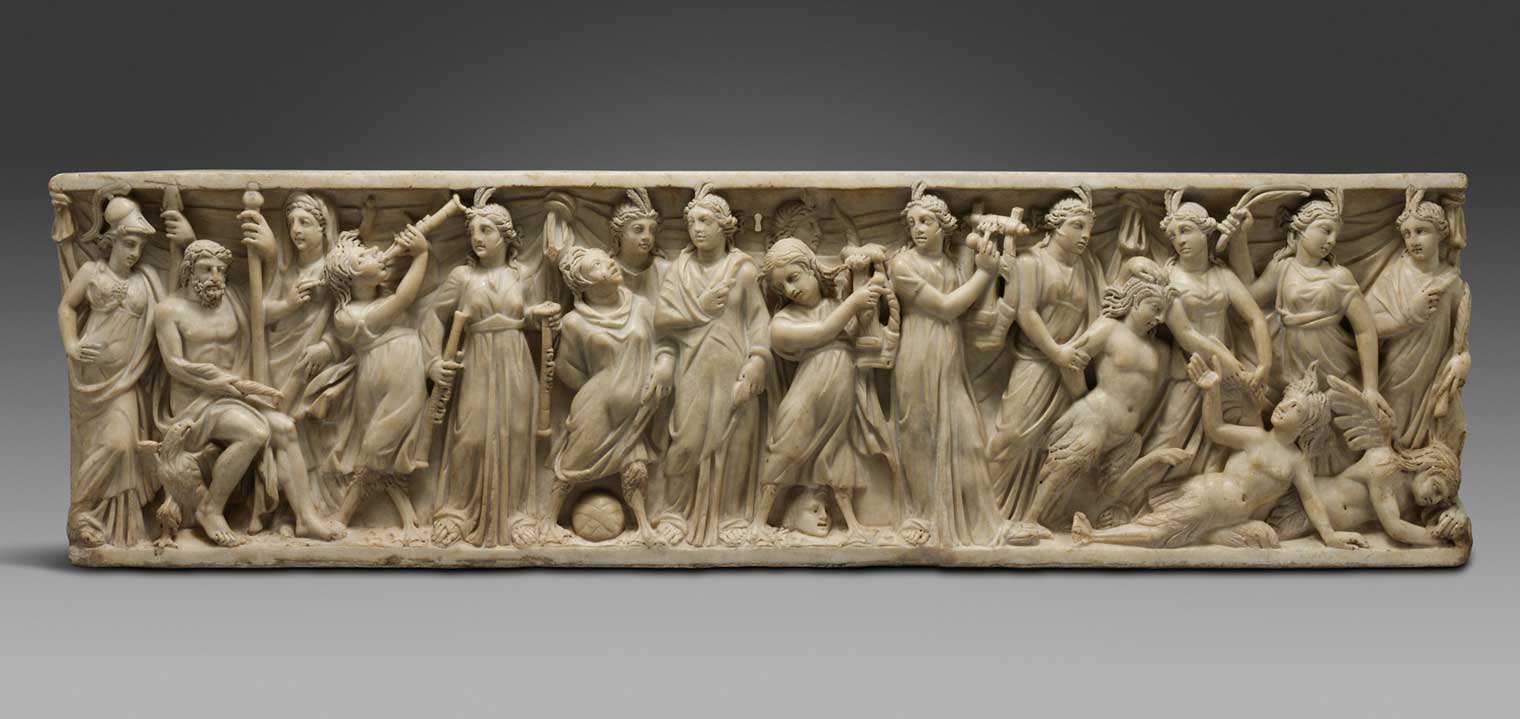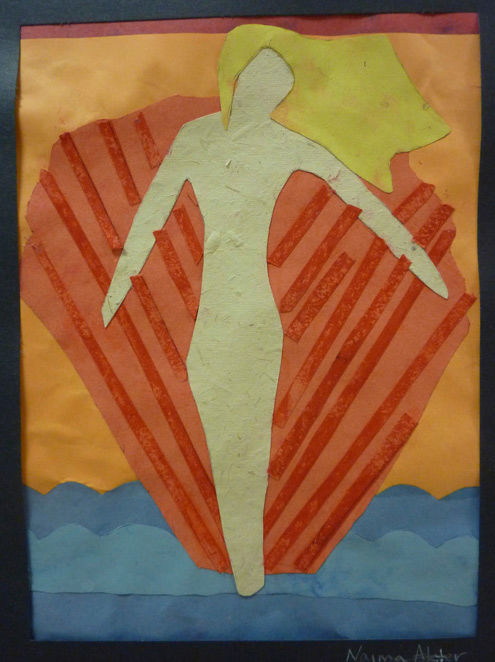Muses vs. Sirens

Marble sarcophagus with the contest between the Muses and the Sirens, 3rd quarter of 3rd century A.D. Roman. Marble, Pentelic, 21 3/4 x 77 1/4 x 22 1/2 in. (55.3 x 196.2 x 57.2 cm). The Metropolitan Museum of Art, New York, Purchase, Rogers Fund, 1910 (10.104)
Collection Area: Greek and Roman Art
Subject Areas: World History
Grades: Middle School
Topics/Themes: Art as a Primary Resource, The Art of Belief
Goals
Students will be able to:
- analyze ancient artifacts in order to deepen understanding of the cultures that produced them; and
- cite visual evidence from works of art to support their claims about Roman culture.
National Core Arts Standards
Visual Arts
Creating: Anchor Standard 1: Generate and conceptualize artistic ideas and work.
Creating: Anchor Standard 2: Organize and develop artistic ideas and work
Responding: Anchor Standard 7: Perceive and analyze artistic work.
Responding: Anchor Standard 8: Interpret intent and meaning in artistic work.
Connecting: Anchor Standard 11: Relate artistic ideas and works with societal, cultural, and historical context to deepen understanding.
Common Core State Standards
English Language Arts
CCSS.ELA-Literacy.CCRA.R.1 Read closely to determine what the text says explicitly and to make logical inferences from it; cite specific textual evidence when writing or speaking to support conclusions drawn from the text.*
CCSS.ELA-Literacy.CCRA.R.7 Integrate and evaluate content presented in diverse media and formats, including visually and quantitatively, as well as in words.
CCSS.ELA-Literacy.CCRA.SL.1 Prepare for and participate effectively in a range of conversations and collaborations with diverse partners, building on others' ideas and expressing their own clearly and persuasively.
CCSS.ELA-Literacy.CCRA.SL.2 Integrate and evaluate information presented in diverse media and formats, including visually, quantitatively, and orally.
History/Social Studies
CCSS.ELA-Literacy.RH.6-8.1 Cite specific textual evidence to support analysis of primary and secondary sources.
CCSS.ELA-Literacy.RH.6-8.2 Determine the central ideas or information of a primary or secondary source; provide an accurate summary of the source distinct from prior knowledge or opinions.
CCSS.ELA-Literacy.RH.6-8.6 Identify aspects of a text that reveal an author's point of view or purpose (e.g., loaded language, inclusion or avoidance of particular facts).*
*Art as text
Questions for Viewing
- Take a moment to look closely at this object. If you are in the Museum, walk around the object and observe it from different angles.
- Select a character from the object and recreate their pose with your body.
- Choose and share an adjective to describe your character. Why did you choose that adjective?
- What narrative seems to be taking place? What details from the object support your story?
- This object depicts a contest between the muses and the sirens. In Greek mythology, muses were goddesses who inspired literature, science, and the arts. Sirens were half-woman, half-bird creatures who lured men to destruction with their song. Can you identify the two "teams"?
- Who do you think is winning the contest? How can you tell?
- This object is a sarcophagus, or coffin for a deceased person. Why would someone want to decorate their tomb this way?
Activity
Activity Setting: Classroom
Materials: Variety of decorative paper, oak tag paper, glue, scissors
Subject Areas: Visual Arts
Duration: 90 minutes
Create a collage to illustrate a Greek myth of your choice.
Step one: Identify an important moment from the myth and the key details you will include to tell the story. Think about how you can depict the characters and setting using organic and geometric shapes.
Step two: Using oak tag paper as a base for your collage, practice moving the shapes around until you find the most dynamic composition. Consider positive and negative space, texture, and balance.

Student work from IS 230Q: The Magnet School for Civics in the Community. Art Teacher: Maria Bonilla
Resources
"Sarcophagus with the contest between the Muses and the Sirens [Roman; in the Villa Nero, Rome]" (10.104) In Heilbrunn Timeline of Art History. New York: The Metropolitan Museum of Art, 2000–. (February 2009)
Awan, Heather T. "Roman Sarcophagi" In Heilbrunn Timeline of Art History. New York: The Metropolitan Museum of Art, 2000–. (April 2007)
Thompson, Nancy L. Roman Art: A Resource for Educators. New York: The Metropolitan Museum of Art, 2007. Download the resource (PDF).
Connections: Olympians, 2011.
Objects in the Museum's Collection Related to this Lesson
Marble sarcophagus with the Triumph of Dionysos and the Seasons, about A.D. 260–270. Roman. Marble, overall: 34 x 85 x 36 1/4 in. (86.4 x 215.9 x 92.1 cm). The Metropolitan Museum of Art, New York, Purchase, Joseph Pulitzer Bequest, 1955 (55.11.5)
Terracotta bell-krater (bowl for mixing wine and water), attributed to the Danaë Painter, about 460 B.C. Greek, Attic. Terracotta, red-figure, H. 11 7/8 in. (30.2 cm), diameter of mouth 13 5/8 in. (34.6 cm). The Metropolitan Museum of Art, New York, Rogers Fund, 1923 (23.160.80)
Terracotta statuette of a siren, about 550–500 B.C. Greek. Terracotta; 8 1/4 x 9 1/2 x 5 in. (21 x 24.1 x 12.7 cm). The Metropolitan Museum of Art, New York, Purchase, Renée E. and Robert A. Belfer Gift, 2000 (2000.276)
Victoria Friedrich, educator, and Maria Bonilla, IS 230Q: The Magnet School for Civics in the Community, 2015